How the Phenomenon of Diagonality Changed the Face of Modern Architecture
THE DARING DIAGONAL
CHAPTER THREE
THE ANCIENT WORLD
EGYPT, GREECE, AND ROME
SECTION ONE
EGYPT
Pyramid, Ramp, and Rotated Axis
“I have trodden these thy ramps as a ramp under my feet whereon I mount up to my mother Uraeus on the brow of Re.”
From the Pyramid texts
EGYPTIAN ANTECEDENTS
The roots of 20th century Diagonality go back over 4500 years to the architecture of ancient Egypt. This may seem a curious assertion in light of the fact that the right angle dominated the geometry of construction throughout ancient Egypt. Consider the right angle geometry of Egypt’s post and beam construction, or the linear manner in which its temples were extended along a central like links on a chain, or the 90º layout of ancient Egyptian cities, or the frontalism of Egyptian sculptures and paintings that abhorred a three-quarter view. So, one might ask, where does one find the roots of 20th century Diagonality in ancient Egypt?
In this chapter we examine the very earliest antecedents of Diagonality in ancient Egyptian architectural monuments; what may be called the seminal events. Some of these works, like the pyramids, have been visible since the time they were created [Fig. 3.1] while others, like the ramps at Hatshepsut’s funerary complex [Fig. 3.2] have been buried beneath layers of sand and time’s debris and have had to wait until archaeologists uncovered and restored them many centuries later.
Fig. 3.1 Pyramids at Giza

Fig. 3.2 Hatshepsut’s Funerary Complex
In examining the many architectural monuments of ancient Egypt, it quickly becomes obvious that the geometry underlying their design was dominated by the right angle. The layout of walls and the disposition of columns in uncountable temples, tombs and private dwellings was based on the tried and true 90º angle. [Fig. 3.3] This is so, in part, because the Egytpian’s found the right angle to be boundlessly practical and a highly efficient way to build, particularly in stone. Stone became (after sun-dried and kiln-dried mud brick) the material of choice for the deliberately built-to-last monumental structures erected during this long historical era.
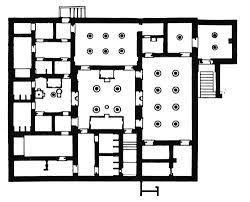
Fig. 3.3 Plan of Vizier Nakht’s house, Tel-el-Armana. Dynasty XVIII. 1372-1350 BCE
As mentioned in the previous chapter, cutting the end of a stone beam at a 45° angle requires much more time, energy, and care than cutting it at a 90° angle because so much more material must be sawn through when the angle of the saw cut is oblique. Moreover, angle cuts that depart significantly from the right angle result in sharp corners that can break during cutting and are vulnerable to possible fracture by military assault or by a building’s inherent gravity-driven structural forces. To these advantages we again mention the space-making advantages of rectangular rooms over more complex polygonal shapes.
NATURAL CONDITIONS AND PERPENDICULARITY
The Nile cuts a roughly northern course through a good portion of lower Egypt, the portion closest to the Mediterranean, while the sun travels a path from east to west. The river and the sun’s path form an implicit perpendicular cross axis that orders much design and construction in ancient Egypt. Generally, most temples and tombs in Egypt are aligned along the east-west axis. The pyramids at Giza are precisely oriented to the cardinal points. The late architectural historian Spiro Kostoff comments on this when he writes: “Orthogonal planning came naturally both in the field division of the Black land and in the design of cities. We have only to compare the tangled layout of later Sumerian Ur with the orthogonal ‘Pyramid city’ of Sesostris II (1897-1878 B.C.) at El Kahun, its main streets running precisely north-south, to grasp the difference between Sumerian and Egyptian order [Fig. 3.4] . . . This is not to say that Egypt was without its organic urban clusters, especially in older cities like Thebes or Memphis . . . [But] The earliest hieroglyphic sign for ‘province,’ or nome, was a rectangle divided into four by intersecting lines; the sign for ‘town’ showed a circular enclosure around an orthogonal street system or a dominant cross-axis.’” (Kostof 1985,1995)
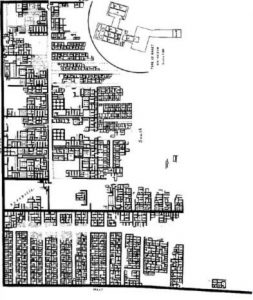
Fig. 3.4 Pyramid City at El Kahun
Like the pharoahs, the right angle ruled with dictatorial authority throughout ancient Egypt’s centuries-long history. The resulting perpendicularity was the pervasive architectural brand of a civilization obsessed with order, longevity (even into the afterlife), and power.
ANTECEDENTS IN THE EXCEPTIONS
It has been natural for historians of all stripes to dismiss, overlook, or at least not attach much importance to those instances when a departure from the right angle was employed. Except for the pyramid, these exceptions to perpendicularity fell outside the realm of interest of Egyptologists, archaeologists and architectural historians, and for their purposes, perhaps rightly so. But for our purposes, it is these exceptions that are of interest and significance in the study of Diagonality. They are the first significant antecedents of the diagonal motif. Those antecedents involve three elements of Egyptian architecture, namely the pyramid, the ramp and the rotated axis.
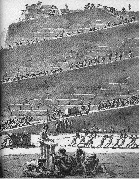
Fig. 3.5 Pyramid City at El Kahun
RAMPS
A ramp is a wedge-shaped structure used by many ancient Middle Eastern cultures in the erection of buildings [Fig. 3.5] and to access upper terrace levels of a complex. [Fig 3.6] To erect a pyramid, it is theorized that long temporary ramps spiraled up from each of its four corners facilitating the movement of men and materials. In finished buildings, permanent ramps were used to lead the faithful from one ceremonial temple terrace to another on which various religious and political ceremonies occurred. The sloping diagonal thrust of a ramp appeared in stark and memorable contrast to the otherwise static, orthogonal composition of the facility it served.
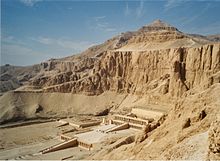
Fig. 3.6 Ramps at Hatshepsut’s Funerary Complex
PYRAMIDS
The pyramid is a uniquely Egyptian invention. Pyramids, built during the Old Kingdom (2700 BCE to 2200BCE) are perhaps the most memorable icons of Egyptian culture. They are believed to have served many functions beyond that of pharaonic tomb as will be described later in this chapter. [Fig. 3.7]

Fig. 3. 7 Pyramids at Giza
In passing, it is worth noting that Egypt was not the only ancient civilzation that built pyramids. The kings of Kush in Nuri, Sudan built tombs [Fig. 3.8] over a period of three centuries (664-300 BCE) and over them erected large steeply sloping pyramids that were only slightly smaller than those built in Egypt.
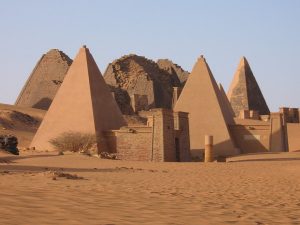
Fig. 3. 8 Pyramids in Nuri, Sudan
THE ROTATED AXIS
The third element in the trio of antecedents is not a structure but a relationship between structures or a relationship between components of a single complex. This third element is the rotated axis that begins with the centerline of an otherwise orthogonal structure, then veers off in at a different angle. The rotated axis appears in temple complexes such as those near Karnak and Luxor situated on the east bank of the Nile. [Fig.3.9] The rotated axis is in a way the most abstract feature of the early antecedents and also the one that is geometrically most closely associated with the expressionistic aspects of 20th century Diagonality.
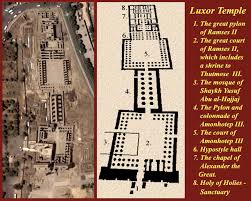
Fig. 3.9 Luxor Temple
AXIALITY, PROCESSION, AND FRONTALISM
All three Egyptian antecedents of Diagonality (ramp, pyramid and rotated axis) are united by the common theme of axiality, it being one of the most dominant aspects of Egyptian art and architecture. Rooms in most tombs and temples, for instance, were symmetrically disposed like mirror images on either side of a central axis. Temples usually expanded by the addition of new wings added as forward extensions of the preceding construction. Each Pharaoh added his (or her) wing to the temple complex in the form of a court, a hypostyle hall, or a pylon gate—much as a child at play will add a new wooden block to the forward end of a chain of blocks extending across a rug.
In the case of the Egyptian temple, whose central axis was usually oriented in rough alignment with the east to west route of the sun, the faithful moved in processions in directional concert with the sun’s course across the sky. Their processions were marked by their encountering and then passing through a series of pylon gates, which faced the participating priests in a plane perpendicular to the processional route.
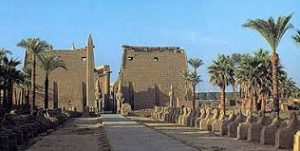
Fig. 3.10 Front-on view of pylon at Luxor Temple
[Fig. 3.10] The right angle is evident not just in the implied grid underlying the structural system of columns and beams but also in the perpendicular relationship of participant to the orthogonally organized matrix of architectural spaces. Procession implies movement from point A to point B, from a beginning or birth, to an end, or destination, or death. The inherent relationship between axis and cross-axis implies frontality. This frontal engagement of building and visitor, a rigid one that left little room for freedom of action, is reflected in the frequently discussed frontalism of Egyptian art where individuals are usually painted in stiff profile with the face in profile but the upper body rotated to reveal both shoulders. [Fig. 3.11]
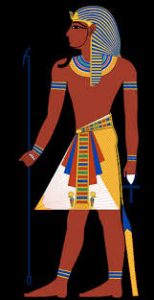
Fig. 3.11 Example of frontalism
Against this background of right-angle construction, axiality, procession, and frontality, the three Egyptians antecedents of Diagonality are now examined in greater depth.
THE PYRAMIDS
From Mastabas To Pyramids
The Egyptian pyramids are important as an antecedent of Diagonality these reasons: first is their form, second is the mathematics involved in their design and construction, third are the functions the pyramids are believed to have served beyond that of a burial chamber.

Fig. 3.12 A Cros section through a mastaba

Fig. 3.12 B A cluster of mastabas
The great pyramids at Giza were constructed during the 4th dynasty of the Old Kingdom around the period 2,570 and 2500 BCE making these sublimely simple structures roughly 4,500 years old. They emerged out a long period of development in which mastabas, [Fig. 3.12 A & B] with their exterior veneer bricks arranged in geometric patterns, and stepped pyramids (a stack of mastabas progressively getting smaller toward the top) kept reaching skyward for a more perfect, more elemental angular expression. It was ultimately the steep slope and simple geometry of the pyramids combined with their polished stone faces and capstones overlaid with gold that lifted the pyramids to a realm of transcendent distinction.
FORM
The pyramid is a simple, stable structural form exuding an air of extreme repose and everlasting life. The sides of a pyramid are neither wall nor roof, but rather a merger of the two. Regarded otherwise, they are not even a merger of the two because both wall and roof (the words) imply the existence of a habitable space within. Pyramids, as the Egyptians used them, are solid masonry masses save for very minor access corridors, ventilation shafts, and the burial chambers which are physically and functionally at the heart of the construction.
A pyramid’s form is unique in the wide range of architectural forms. Its geometry is elemental—a five-sided polyhedron consisting of a square base and four equal triangular faces, each being an isosceles triangle. The only polyhedron that is more elemental than a pyramid is the tetrahedron which consists of a triangular base and three triangular sides, each equal in size and shape to the other sides.
The architect, Imhotep, first architect in the world known by name and reputedly also a writer and physician, designed the first pyramid around 2630 BCE for the Third Dynasty Pharaoh, Djoser. The pyramid was part of Djoser’s large funerary complex at Saqqara, outside of Memphis. This complex is of great importance because it was the first monumental stone construction in ancient Egypt. But this particular proto-pyramid was not a true pyramid. Begun as a mastaba, the ‘pyramid’ grew over time to rise in six clunky ‘steps,’ actually six mastabas stacked one atop the other. [Fig. 3.13] One hundred and ninety-seven feet high, its base was in fact not a square but rather a rectangle that measured 397’ by 358’. Although impressive, it lacked the architectonic power and geometric purity of the later Great Pyramids at Giza.

Fig. 3.13 Djoser’s stepped pyramid at Heb-Set court
After construction of the pyramid at Saqqara, but before the Great Pyramids were built, at least three other pyramids were erected before perfection was realized. All three earlier ones were built for Sneferu (2572-2551 BCE) whose cult remained strong for over 2000 years. Sneferu’s first pyramid was built six miles south of the one at Saqqara, at Meidum, and was actually built over an earlier stepped pyramid. Two overbuildings were erected on top of the stepped pyramid but they collapsed due to poor engineering. The slope of the sides of this pyramid are at an angle of 51º50’35,” extremely close to the angles later used at Giza. Had it survived it would have been 302’ feet high. Concerned about another collapse, the profile of Sneferu’s second pyramid, under construction at the same time as his first, was altered about half way up and the angle of incline to the top reduced from an adventurous 54º27’44” to a much more conservative angle of 41º22’. The result, even though it reached a height of 344 feet, is architecturally unfortunate. Called the bent pyramid, it suffers from a demeanor expressing both uncertainty and timidity. [Figure 3.14]

Fig. 3.14 Sneferu’s Bent Pyramid
Senferu’s third pyramid, very nearby the second, rises to the same height but utilizes the lower angle of inclination. It too appears indecisive, looking like a monument whose architect decided to play it safe rather than let the structure rise in daring glory.
The greatest and best-known pyramids in Egypt were built on a hand-hewn rocky plateau, about a mile square, located ten miles west of the modern city of Cairo and close by the ancient city of Memphis. Nine pyramids sit on the plateau although most people fixate on the three largest built by Sneferu’s descendants. The tallest, and first-built of the three, bears the name of Khufu, (Cheops, according to Greek transliteration). This pyramid was faced with polished limestone, a material initially easy to work but which continues to harden over time. Herodotus reportedly saw the pyramid in 440 BCE during his grand tour of ancient Egypt and wrote (the first, in fact, to write about the pyramids) that the polished mantle on all four faces was still perfectly intact and the joints were so fine they could barely be seen— his report made roughly 2000 years after the pyramid was built! That is a remarkable standard of excellence in light of the fact they were built without mortar and with relatively primitive hand tools. Four hundred and fifty years later still, the Greek historian Diodorus Siculus described the mantle’s still-perfect condition.
The base of Khufu’s pyramid measures 755’ x 755’ and covers thirteen acres. The casing stones were so accurately laid that the joints were only 1/50th of an inch thick, or roughly the thickness of five sheets of paper. The layout and construction were so precise that only one side of the pyramid is off by a mere 1-3/4”. The pyramid rises to a height of 481 feet; the apex is off center of the base by only one foot and the base is out of level by less than a foot. One wonders whether these imperfections are the result of earthquakes, evidence for which could be the shedding of the pyramid’s polished stone mantle, rather than errors in construction.[Fig. 3.15]

Fig. 3.15 Khufu’s pyramid, Gizeh.
The pyramid contains three burial chambers, one built under the pyramid (chiseled out of solid rock), and two built in the body of the pyramid as it rose skyward. The lowest chamber, crudely fashioned, is believed to represent the underworld. The middle chamber, called the Queen’s chamber, served as Khufu’s spirit chamber, and the topmost chamber, built of granite in an mountain of masonry otherwise composed of limestone, is called the King’s chamber and held the sarcophagus protecting his remains. Granite beams and massive granite slabs, ingeniously contrived, work to relieve and deflect the weight of the stone mass above. Small shafts angle upwards and outwards from the King’s and the Queen’s chambers, these thought by some to have possibly provided ventilation during the construction process. These shafts are not arbitrarily oriented—as a ventilation shaft might be. The shaft on the north side is aligned with the pole star and the one on the south side aligns with Orion. Some theorists, such as Peter Tomkins who wrote the Secrets of the Great Pyramids, suggest these shafts contain cosmic or at least astronomical significance, particularly in light of other known aspects of the pyramid’s orientation, such as its compass orientation, which is only five and a half minutes of arc off true north. Modern Egyptologists seem convinced, however, that the pyramids were above all else tombs for the pharaohs and little else. But, Stonehenge was long believed to be just a place for prehistoric ritual and not a calendar. Certainly the Egyptians’ obsession with the god-like significance of the sun and its east-west movement across the sky, and the precise compass orientation of the great pyramid’s at Giza, suggests that the design of the great pyramids transcended, to some degree, the concerns of mere tomb building.
The once-dazzling mantle no longer exists on Khufus’s pyramid but a suggestion of it remains today at the top of the adjacent pyramid, Khafre’s (Chefren’s by Greek transliteration). Khafre was Khufu’s son. This pyramid, built of red granite, is actually slightly smaller than Khufu’s but appears taller because it is built on higher ground. The third pyramid, built in something of a hurry and not to the same exacting standards was for Khafre’s son Menkaure (Mykerinos, in Greek). Six diminuitve pyramids, supposedly built for the wife and daughters of Khufu, complete the Giza complex. Dotting the western bank of the Nile south from Giza in the direction of the Sudan stand roughly a hundred more pyramids, much smaller and in varying states of decline both in height and structural integrity.
One can imagine the sun hitting the south-facing triangular planes of these pyramids at just the right angle sending a beam of blinding sunlight east across the Nile or north, up the Nile so that any soul, fellah in the field, man of commerce, or high priest—would know that the power and spirit of the everlasting life-giving sun was here on earth in the body of the indomitable Pharaoh.
Again, quoting Kostof, “In several statements of the Pyramid Texts, the earliest preserved body of religious literature carved on the walls of royal tombs, the pharaoh is described as using the rays of the sun, in place of a staircase, to ascend to Re: ‘I have trodden these thy ramps as a ramp under my feet whereon I mount up to my mother Uraeus on the brow of Re.’ Heaven straightened these rays of the sun, we are told, to facilitate this ascent.”
As anyone who has viewed a low sun as it shines down through clouds has observed that the light radiates out in sloping rays that create the impression of a series of pyramids. One is left to wonder whether this vision inspired the Egyptians to replicate the scene in limestone. The sun, whose power and significance is undeniable, is rendered real and palpable in this cloud enhanced revelation as illustrated in [Fig. 3.16].

Fig. 3.16 Rays of sun on pyramids
The pyramids were built to ‘commemorate the rule of the pharaoh, divine and all-powerful, and to ensure the perpetuity of his cult…[The pyramids] proclaimed the truth of the promise: ‘I am the light of the world…He that believeth in me, though he were dead, shall never die.’” (Kostof 1985,1995)
Khufu’s pyramid is the first and only survivor of the Seven Wonders of the Ancient World (a list of manmade structures compiled by Greek writers of the 2nd century BCE). Worth noting is that another of the Seven Wonders, Pharos, the long-gone Greek lighthouse in Alexandria is also part of Diagonality’s history.
Khufu’s pyramid is arguably the best-known manmade structure in the world. Part of the reason is its sheer height at 450 feet currently, and ten meters higher, originally. Sometime in the 6th century BCE and roughly 2000 years after the great pyramid was built, Thales, the father of Greek geometry, visited the towering mass and reportedly floored a guard by calculating the exact height of the pyramid. This he did by measuring its shadow at the exact time of day when the length of his own shadow equaled his height.
It is not by chance that the pyramids at Giza are almost perfectly aligned to true north. Peter Tomkins, (The Secret of the Great Pyramid), claims that the accuracy is so precise that as of the 1970s, modern compasses were adjusted to the pyramids’ orientation, not the other way around.
FUNCTION
Most people know that the pyramids were built to house, forever undisturbed, the remains of pharaohs and royal family members. They housed all the material objects it was believed that the god-king would need for the eternal journey of the corpse before reuniting with his soul. What is less well known is the nature of the sophisticated mathematics that was necessary to build the pyramids, the know-how in structural engineering required to keep them intact, and the incredible accuracy of the techniques employed to chisel and assemble the huge stone blocks. (Copper, a relatively soft metal, was the hardest metal available to the Egyptians for their chisels.) Even still less well known than the math is the role these deceptively simple architectural artifacts likely played in terms of codifying the rhythms and periodicity of cosmic events. Astronomy was an obsession in this ancient culture whose nighttime sky was ablaze with a panoply of fixed stars, roving planets, and rogue incandescent streamers.
MATHEMATICS
There have been many claims by mathematicians, historians and Egyptologists about what the Egyptians knew and what they didn’t know regarding geometry and mathematics. If the Royal Library at Alexandria, founded around the beginning of the third century BC during the reign of Ptolemy II of Egypt had not burned, destroying its 400,000 to 700,000 parchment scrolls, perhaps we would have a better idea what exactly the Egyptians did know in these fields. It is widely believed that the Ancient Greeks studied with the Egyptians and some experts hold that what is often attributed exclusively or primarily to the Greeks regarding mathematics and geometry may in fact have been first discovered or developed by the Egyptians and the nearby Sumerians.
One of the most important numbers in mathematics is 1.618. It is a value that echoes repeated through history. It relates to a ratio, specifically the Golden Ratio, also known as the extreme and mean ratio. Euclid described it thusly: “A straight line is said to have been cut in extreme and mean ration when, as the whole line is to the greater segment, so is the greater to the less.” We arrive at 1.618 as follows where Ø equals the greater segment and 1 equals the shorter segment.
Ø/1 = (1+ Ø)/Ø
so
Ø2 = 12 + 1Ø
resulting in the following quadratic equation
Ø2 – Ø – 1 = 0
therefore
Ø = 1/2 + √ 5/2 = 1.618
The symbol Ø is called Phi for Phidias, the famous sculptor and artistic director of the Parthenon who, some believe, used the ratio in his designs. (Phi is not to be confused with Pi) Some experts believe the Great Pyramid at Giza utilizes Phi, the Golden Ratio. If one cuts a cross section through Khufu’s pyramid one obviously sees a triangle, which not surprisingly is called the Egyptian Triangle. It also goes by the names Triangle of Price and the Kepler Triangle. This triangle reportedly expresses the Golden Ratio in the following manner. The ratio that results from dividing the slant height of the pyramid (186.369 m) by half the width of the base (115.182m) equals 1.61804 or a number that is very close indeed to the Golden Ratio (actually only one unit off in the fifth decimal place). From this (and sparing the non-mathematician the actual computations) one can derive the conclusion that the height of the Great Pyramid equals √ Ø confirming, it would seem, that Khufu’s pyramid does in fact ‘contain’ the Golden ratio.
It was also claimed that the perimeter of the base of the Great Pyramid equals the circumference of a circle whose radius is equal to the height of the pyramid. If this in fact was a goal, the Egyptians got the square and the circumference of the circle to agree to less than one-tenth of one percent or 0.1%. (Calter 2004)
The pyramid is not an arbitrary assemblage of inclined planes that someone thought would be beautiful. There was a geometric logic to the construction. They could have settled on the equilateral triangle in which the angle of all three vertices is the same at 60º. But they did not. Or they could have memorialized the very valuable 2,4,5 triangle.
The Egyptians utilized their technique of creating right angles to establish the angle of the sloping sides of the great pyramids. They used the right angle triangle with sides equal to 3, 4 and 5 respectively to create the hypotenuse [side 5] connecting the ends of sides three and four. If one mirrors this triangle, that is side 4 backed to side 4, the shape of the pyramids is formed. The Egyptians, some suggest, believed this triangle reflected the very structure of the universe. [Fig. 3.17]
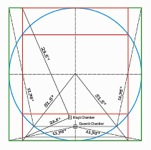
Fig. 3.17
The angle of incline which is the angle between the base and the sloping side is 51º50’ or nominally 52º. It became the standard slope for all pyramids. This angle, created through use of the 3,4,5 triangle, is also the only right triangle having the length of its sides occur in arithmetical progression. It is sometimes referred to as the sacred triangle of Pythagoras or of Plutarch.
THE RAMPS at HATSHEPSUT’S and MENTUHOTEP’S MORTUARY TEMPLES
The history of the permanent architectural ramp goes at least as far back as the single ramp used at the Funerary Temple of Mentuhotep built in 2052 BCE in Deir el Bahari, Egypt. [Figure 3.18] Mentuhotep was a Middle Kingdom prince from Upper Egypt who ruled from the then-capital of Egypt, Thebes, a town situated near a crook in the Nile across from many rich archaeological sites in Karnak and Luxor. Mentuhotep’s temple consisted of a large forecourt leading to a ramp at the western end, which in turn led up to the rock-cut temple itself. It has been thought that a traditional pyramid rose from the center of the temple and although the temple has been illustrated that way for many years the existence of the pyramid cannot be confirmed. Mentuhotep’s actual tomb, deep inside the mountain, was accessible through a long tunnel that ran beneath a large hypostyle hall. Worth noting because of geometric developments that were to occur later in ancient Greece is the fact that eighty octagonal columns filled this hall. The octagon and other multifaceted polygonal shapes were used as the plan section of columns in ancient Egypt but polygons were not yet used to shape buildings or interior spaces.

Fig. 3.18 Funerary Temple of Mentuhotep
At the same time that the pyramids that were built after those at Giza began to shrink in height and decline in constructional quality, the size of mortuary temples was increasing. Mentuhotep’s funerary temple seems to reflect that transition with both pyramids and temples. While this was occurring, a new chief/god rose in importance, Amon, who transcended the authority of his predecessor, the sun god, Re.
The ramp at Mentuhotep’s funerary temple became the model for the larger and far more dramatic ramps at the funerary complex for Queen Hatshepsut, which was built five hundred years later immediately to the north of Mentuhotep’s Temple.
Most pharaohs in Egypt had been men. An exception was Queen Hatshepsut (1473-1458 BCE), a beautiful, peace-loving woman with little interest in foreign domination although some Egyptologists describe her as having been ‘vain, ambitious, and unscrupulous.’ (Gideon 1964) Vain she may have been in plastering her image and sculptures of her lovely young figure all over her Mortuary Temple; ambitious she was by displacing her Pharaoh husband in order to ascend to the throne.
Queen Hatshepsut had a close and collaborative relationship with her architect and intimate friend, Senmut, with whom she had a ‘close spiritual and corporeal affinity.’ (Gideon 1964) Senmut possessed ‘almost unlimited power.’ With the title ‘Overseer of Overseers of All of the Works of the King,’ Senmut was responsible for everything Queen-related right down to being “Superintendent of the Private Apartments, of the Bathroom, and of the Royal Bedrooms as well.”
The rock-cut mortuary complex the two of them created in Deir el Bahari during the two decades she ruled, (Eighteenth Dynasty 1511-1480 BCE), is a simple dramatic composition of three broad terraces (about 300 feet across) that terminate against a backdrop of the mountain from which the temple was carved. [Figure 3.19] The terraces and their columnar porticoes are united and accessed by huge processional ramps that are almost as long as the terraces are deep. The ramps are beautifully scaled to the breath of the terraces and to the scale of the mountain, to the vast blue canopy of the sky, and to the expanse of cultivated fields that stretch eastward to the Nile beyond. The ramps are aligned with the centerline of the temple complex at Karnak just then starting construction across the Nile to the east.

Fig. 3.19 Funerary complex for Queen Hatshepsut
Hatshepsut and Senmut’s monumental contribution to world architecture is multi-faceted. Regarding the conventional appreciation of Egyptian architecture, historian Christian Norberg-Schulz offers that Hatshepsut’s temple ‘produced a fundamental advance in the development of architecture as a symbol system. This advance was a full materialization of axially organized, orthogonal space. The orthogonal system is no longer drawn on the surfaces of megalithic masses or excavated within them, but is realized as an open repetition of posts and beams.’ (Norberg-Schulz) The other less obvious achievement of this complex, and central to our theme, is the demonstration of the power of the inclined plane. Great ramps have been designed over and over in 20th century architecture and have been an integral part of the modern diagonal motif.
Today the terraces at Hatshepsut’s temple are dramatic, sand-covered expanses but in her time they were lush verandahs covered with imported trees planted in earth-filled pits and irrigated by underground pipes. Perhaps one reason the ramps took so long to impact the future course of architecture is that Mentuhotep’s Temple complex and Hatshepsut’s complex were hidden from view until about 1800 at which time the debris that covered them was removed and their restoration commenced.
Far beyond their mere functional value as a means of simple ascension, it is obvious that the ramps of ancient Egypt were used as an expressive symbol of processional movement and of ascent toward a loftier state. In modern architecture they have been used to tie together a stack of floor levels, and create a contrapuntal geometric contrast to right angle construction. Most importantly, ramps, by their very diagonal relationship to horizontal floor planes, add that final thrusting feature needed to make an angular building compositionally complete from the perspective of diagonality.
THE ROTATED AXIS
An axis is an imaginary line that runs through the center, or usually the center, of a single building or complex of buildings around which the major rooms or wings are organized. In most buildings built before the 20th century, the rooms were usually arranged symmetrically on either side of the central axis. Rooms that appeared on one side of the axis were predictably mirrored on the other side whether function required it or not. This was likely the result of a mindless replication of and, concurrently, the veneration for the symmetry found in the human body and in almost all other organisms that move — which a building is not. (Many organisms, including humans, are, of course, symmetrical on the outside but composed of an asymmetrical jumble of organs on the interior. Speaking simplistically, the exterior symmetry is in part required for balance during locomotion while the interior ‘chaos’ is primarily function-driven. Modern man has come to realize that what often appears to be chaos, such as the appearance of a forest or the jumble of organs in a living creature, is the combination of what cosmologists and evolutionists refer to as chance and necessity.)
Ancient Egypt was a civilization dominated by axially organized buildings, each of which may be seen as echoing to some degree the axis of the Nile that is flanked for much of its length by agricultural plains and in some areas by space-defining palisades. The architectural axis in Egyptian architecture is expressive of the commemorative procession that occurred within its temples, that is the ritual passage of priests that often continued beyond the pylon gates to a destination outside the building, even as far away as temples on the other side of the Nile.
In a culture so dominated by the right angle, it would certainly have been an act of supreme authority and/or compelling need to crook the straight line of a building’s axis in any addition to the complex — that is to ‘rotate’ the extended axis off its previously established course. Nevertheless, axial rotation did occur in ancient Egyptian architecture on rare occasions. While rotation 3500 years ago was not employed for its own sake — that is to say an architect or ruler did not rotate an architectural axis to be au courrant — in the 20th century, however, axial rotation became a frequently used architectural motif oftentimes used because it was the modern way space could be and oftentimes should be organized, and it remains a chief feature in the design vocabulary of 21st century architects. Twentieth century views of space, architectural and otherwise, were far more complex than they had been ever before — and this seemed to call for a more nuanced attitude to spatial organization in buildings. Moreover, democratic societies needed to account for and express the interests and views of a diverse constituency — no longer was there a single, royal straight-line view of the world; i.e. multiple perspectives called for multiple axes.
The earliest and most striking antecedents of axial rotation in ancient Egypt occurred in buildings located on the banks of the Nile in three main temple complexes at the famous sites known today as Luxor and Karnak (the area comprising both known earlier as Thebes). [Figure 3.20] This area is on the east bank of the Nile across from the modern day city of Thebes and across from the ancient necropolis nestled against the palisades of Deir el Bahari we discussed earlier in this chapter.

Fig. 3.20 Processional route linking Luxor (foreground) with Karnak
All three of these temple complexes were individual religious centers devoted to Amon (alt. Ammon or Amen) ‘the supreme god whom the reigning monarch traditionally claimed as his (or her) father.’ (Janson 1962) Two of the complexes (the Great Temple of Amon at Karnak and the temple of Amon at Luxor) are still linked by an ancient, slightly curving, sphinx-bordered processional route a little over a mile long. [Fig. 3.21] The third complex involved in this discussion of axial rotation is the Temple of Mut, within the walled Precinct of Mut, which is positioned relatively close to the walled compound of Karnak.

Fig. 3.21 Avenue of Sphinxes facing pylon at Luxor
All three temples are each composed of a series of connected halls, courts, colonnades and portal gateways (known as pylons, a Greek term), symmetrically disposed along a central axis like railroad cars on a straight run of track. The primary temple complex at Karnak is situated within a large walled compound in which various other discrete temples and courts have been built. The all-embracing walled enclosure is referred to as the Precinct of Amon or Amun. [Fig. 3.22]

Fig. 3.22 Causeway linking Luxor (foreground) with Karnak
At the Temple of Amun-Mut-Khonsu to the south, referenced more frequently as Luxor Temple (which is the term we will use in this discussion), the halls and courts and pylons were added incrementally over time by two pharaohs, much as one would add cars to the aforementioned line of railroad cars. Luxor was started in 1417 BCE by Amenhotep III and dedicated to the imaginary entities Amun (the sun god), his consort, Mut, and their son, Khonsu. The additions built later (around 1379 BCE) each bring the front of the complex a tad closer to the temple complex at Karnak. The last court to be built is shown at the bottom of the photograph below.[Fig. 3.23]
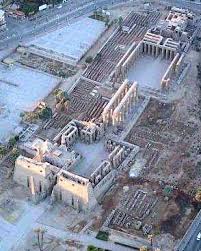
Fig. 3.23 Aerial view of Luxor
Although the earliest temple additions at Luxor follow one after the other along an absolutely unbending, centrally situated straight axis, the alignment of the final two additions or links angle off from the original axis at a puzzling slant, or more precisely slants because the final addition of the forecourt angles even more obliquely than the first errant addition, the colonnade. For this to occur in a culture obsessed with straight-line processions immediately invites speculation. To rotate the axis at Luxor must have been for its creator an expression of supreme authority and self-confidence for it was a clear break with a tradition that was literally and figuratively cast in stone by the preceding king.
When I was a student of architecture at the University of Pennsylvania and first saw a plan of the Temple at Luxor in the had-to-have book Key Monuments of World Architecture, I was certain there had been a misprint of the page; that the paper had slipped in the press resulting in a portion of the floor plan being skewed. [Fig. 3.24] How else to explain this peculiar anomaly, this wiggly arrangement of architectural spaces in the context of other rigidly orthogonal floor plans? Even though I was a student myself in what I later came to call the Age of Diagonality, this image of an ancient building with a twice-shifted axis certainly seemed more reasonably explainable as a printer’s mistake than a deliberate act by a sober and serious temple builder. There was no way this shifted axis could simply have been the mistake of the survey crew laying out the foundations for the temple’s next expansion. And yet nothing in the text explained rotation. However, when I later saw plans of Luxor in other books and the axis was also awry, it made an indelible impression on me as an architectural configuration that was very peculiar indeed.
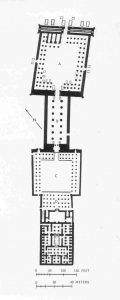
Fig. 3.24 Plan of Luxor
Over time I discovered several explanations for this remarkable axial shift at Luxor. One was that during the Nineteenth Dynasty, Ramses II (1279-1213), who built the colonnade, court yard, and pylon whose axis [sic] shifts from the axis of the earlier temple components, wanted to have the axis of his structures align with the course of the Nile (Janson 1962). [Fig. 3.25] Unless the Nile shifted alignment over several thousand years, (which is possible) this theory seems to be contradicted by the geography of existing conditions. It also seemed like a lame explanation because while the axis of Luxor was rotating to the east, the temple of Karnak kept expanding to the west directly toward and perpendicular to the riverbed of the nearby Nile that Janson proposed was to be avoided.

Fig. 3.25 Ancient Thebes
Another theory was that the realignment occurred because Ramses II wanted the latest structures to align with the processional way, also known as the Alley [alle jl] of the Sphinxes, that connects Luxor with Karnak. That also seems a questionable theory in light of the fact it would be easier and less architecturally traumatic to relocate the sphinxes than to alter the holy and time-honored axis of a temple. Moreover, in some plans of the complex, it appears that the Alley of the Sphinxes aligns with the original roughly north-south axis of the original structures at Luxor rather than to the realignment of the axis introduced by Ramses II.
Sigfried Gideon, the highly respected late architectural historian and expert on ancient cultures seems to regard the axial shift as an unfortunate mistake in his book The Eternal Present: The Beginnings of Architecture. “Later, Ramesses II added a colonnaded court and a pylon at a slight angle to the temple’s north-south axis, which did not improve the whole.” (Gideon 1964) Gideon seems to suggest the axial shift was a mistake with unanticipated consequences. Later, Gideon is still without a theory on the axial rotation. “When Ramesses II completed Amenhotep III’s temple at Luxor, fronting the large new extensions with his great pylon, he did not rationally continue the horizontal axis established by his forebears. His new axis followed more subtle considerations.” (Gideon 1964) Curiously, the ‘more subtle consideration’s to which Gideon refers are never described, but the impression is left that the axial rotation was irrational.
Yet another theory was proposed by the sometimes respected and sometimes vilified renegade Egyptologist, R. A. Schwaller de Lubicz (1887-1961), who worked with an archaeological crew at Luxor including his wife, Isha, for fifteen years starting in 1938. Based on his investigations, the shift in the axis at the temple at Luxor was the result of the “changing angle of the Polar Star throughout the hundreds of years of the complex’s construction. As each section of the temple was designed and built, the axis shifted, requiring a new alignment so that the rising sun would shine through the wonderful halls of pillars to the shrine within. What is revolutionary and startling about Schwaller de Lubicz’s ideas about the axis shift is that he assumes that the Egyptians knew the entire form of the building before it was built, and acknowledged that they would have to adjust it according to the earth’s astronomical movements. As they certainly knew about the mechanics and mathematics of the precession, they would have known beforehand and integrated such knowledge into their masterpiece.” (Mann 1993)
I am not qualified to prove or disprove Schwaller de Lubicz’s complex thesis, but my own theory, set forth below, if verified by experts, is a much less complicated notion. It is based on what would seem to have been the obvious goals of an architect (who in this case was also the ruling Pharaoh) responding to the changing architectural conditions confronting him at the time.
My theory is that the axial realignment was the result of a two-part desire on the part of Ramses II to position the pylon of his addition in direct alignment with the major side entrance to Karnak which I believe was added after Karnak was started but before the Ramses’ addition was constructed. [Fig. 3.26] Obsessed with axial procession and perpendicularity as expressed in the pylon gates themselves, Ramses II chose to simply shift the direction of his route from its perpendicular alignment with the main axis of the Karnak complex to the new side entrance in the precinct wall which faces the Temple of Mut. Supporting this explanation for axial rotation is the fact that the courts and pylons projecting sideways from the main temple at Karnak also progressively rotate to perpendicularly face the axis if the Temple of Mut. [Fig. 3.27] It is evident that there was a fair amount of axial realignment going on over many years between the various temples and precinct enclosures and that the axial rotation at the Luxor Temple is only the most visually striking and noticeable in situ.
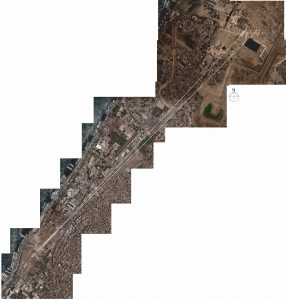
Fig. 3.26 Axial alignment of side entrance to Karnak with final axis of Luxor
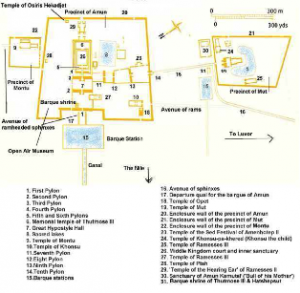
Fig. 3.27 Karnak complex and the Precinct of Mut
Another obvious and compelling reason Ramses II would have altered the original axis of the Luxor Temple is that an older shrine (believed to have been built by Queen Hatshepsut) pre-existed on the axial center-line of the Luxor temple. If the Temple of Luxor’s northerly expansion would have continued un-rotated, the final Luxor temple entrance would have been blocked by the shrine — or the shrine would have had to be destroyed or relocated to preserve the original Luxor Temple axis. The shrine was in fact built into the final pylon but ended up off center of the doorway permitting entry to proceed unimpeded. [Fig. 3.24] There seems to be adequate evidence to support my theory because Egyptian architecture was dominated by straight-line processionals connecting one point in a religious site with another point in a generally direct line, even though the components were built sequentially.
SUMMARY
A great debate has waged for decades on the significance of geometry in ancient Egypt. Some experts believe the Egyptians worked geometry by rule-of-thumb rather than by deductive reasoning from general premises, an approach these experts hold was a Greek invention. Others believe the Greeks are far more indebted to the Egyptians for mathematical constructs than the superficial record would suggest. However one might characterize the geometry of ancient Egypt, this culture produced buildings of extraordinary mathematical and geometric sophistication. Matching the mathematical achievement was the nearly unparalleled precision of their construction, a precision comparable to today’s finest architectural monuments. Working together, these qualities in ancient Egyptian construction resulted in buildings whose architectonic power was of the highest order.
The pyramids, ramps, and rotated axes of ancient Egypt were not precursors of the architectural monuments that emerged in the centuries that immediately followed. But they were antecedents of architectural design that emerged in the 20th and 21st centuries. From the start of the age of Diagonality, ramps and rotated axes were favored architectural design motifs. The Egyptian pyramids, however, remained solid masonry masses until steel and concrete construction in the modern era allowed the pyramidal form to be hollowed out and rendered habitable.
‘[In times past], architects built in solid stones. Now we can build with hollow stones. The spaces defined by the members of a structure are as important as the members. These spaces range in scale from the voids of an insulation panel, voids for air, lighting and heat to circulate, to spaces big enough to walk through and live in. The desire to express voids positively in the design of the structure is evidenced by the growing interest and work in the development of space frames’.
Louis I. Kahn
